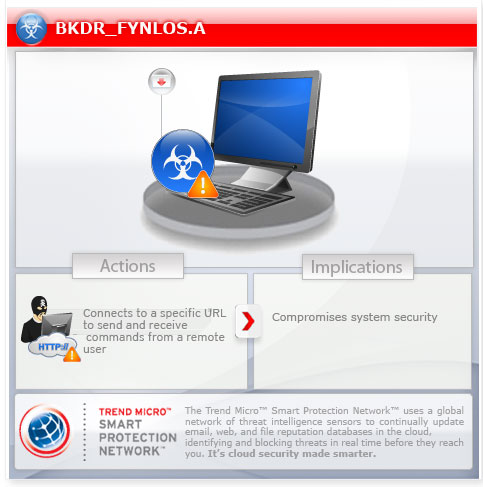BKDR_FYNLOS.A
Windows 2000, Windows XP, Windows Server 2003


Threat Type: Backdoor
Destructiveness: No
Encrypted: No
In the wild: Yes
OVERVIEW
This backdoor is dropped by the malicious .PDF file attached to spammed messages related to the death of the late Korean leader, Kim Jong-il.
To get a one-glance comprehensive view of the behavior of this Backdoor, refer to the Threat Diagram shown below.

This backdoor connects to its C&C server using the parameter. If the backdoor connection is successful, it may perform the certain routines.
This backdoor may be dropped by other malware.
TECHNICAL DETAILS
159,744 bytes
EXE
Yes
20 Dec 2011
Connects to URLs/IPs
Arrival Details
This backdoor may be dropped by the following malware:
- TROJ_PIDIEF.EGQ
- TROJ_PIDIEF.EGR
Installation
This backdoor drops and executes the following files:
- %Application Data%\GoogleUpdate.exe - also detected as BKDR_FYNLOS.A
(Note: %Application Data% is the current user's Application Data folder, which is usually C:\Documents and Settings\{user name}\Application Data on Windows 2000, XP, and Server 2003, or C:\Users\{user name}\AppData\Roaming on Windows Vista and 7.)
Autostart Technique
This backdoor adds the following registry entries to enable its automatic execution at every system startup:
HKEY_CURRENT_USER\Software\Microsoft\
Windows\CurrentVersion\Run
GoogleUpd = "%Application Data%\GoogleUpdate.exe"
Backdoor Routine
This backdoor connects to the following URL(s) to send and receive commands from a remote malicious user:
- {BLOCKED}.{BLOCKED}.173.119
As of this writing, the said sites are inaccessible.
Other Details
This backdoor connects to the following URL(s) to check for an Internet connection:
- http://www.google.com/search?qu=
NOTES:
It connects to its C&C server using the parameter:
- /search{numbers}?h1={value}&h2={value}&h3={encoded computer name}&h4={encoded volume serial number}
If the backdoor connection is successful, it may perform the following routines:
- Download / upload files
- Execute / delete / copy file
- List / terminate processes
- List / change directories
- Perform shell commands
SOLUTION
9.200
8.660.08
23 Dec 2011
8.661.00
23 Dec 2011
Step 1
Before doing any scans, Windows XP, Windows Vista, and Windows 7 users must disable System Restore to allow full scanning of their computers.
Step 2
Remove malware/grayware files that dropped/downloaded BKDR_FYNLOS.A
Step 3
Identify and terminate files detected as BKDR_FYNLOS.A
- Windows Task Manager may not display all running processes. In this case, please use a third-party process viewer, preferably Process Explorer, to terminate the malware/grayware/spyware file. You may download the said tool here.
- If the detected file is displayed in either Windows Task Manager or Process Explorer but you cannot delete it, restart your computer in safe mode. To do this, refer to this link for the complete steps.
- If the detected file is not displayed in either Windows Task Manager or Process Explorer, continue doing the next steps.
Step 4
Delete this registry value
Important: Editing the Windows Registry incorrectly can lead to irreversible system malfunction. Please do this step only if you know how or you can ask assistance from your system administrator. Else, check this Microsoft article first before modifying your computer's registry.
- In HKEY_CURRENT_USER\Software\Microsoft\Windows\CurrentVersion\Run
- GoogleUpd = %Application Data%\GoogleUpdate.exe
- GoogleUpd = %Application Data%\GoogleUpdate.exe
Step 5
Scan your computer with your Trend Micro product to delete files detected as BKDR_FYNLOS.A. If the detected files have already been cleaned, deleted, or quarantined by your Trend Micro product, no further step is required. You may opt to simply delete the quarantined files. Please check this Knowledge Base page for more information.
Did this description help? Tell us how we did.


